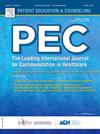Physician-dominated conversations: An analysis of illness understanding discussions among patients with advanced cancer
IF 2.9
2区 医学
Q2 PUBLIC, ENVIRONMENTAL & OCCUPATIONAL HEALTH
引用次数: 0
Abstract
Context
Effective communication between patients and oncologists is crucial, particularly around illness understanding. When this communication is asymmetric or imbalanced, it can hinder shared decision-making and lead to suboptimal clinical outcomes.
Objectives
We sought to describe physician-patient speech imbalances (“asymmetry”) in illness understanding portions of discussions between oncologists and advanced cancer patients and explore potential trends related to patient characteristics.
Methods
Our study included 285 audio recordings of outpatient encounters between 40 oncologists and 139 patients with advanced cancer. We identified illness understanding communication via manual data annotation and analyzed clinician-patient speech ratios. For this project, a communication outcome of “asymmetry” was defined as taking place when one party spoke more than 60 % of all spoken characters related to illness understanding in the conversation. We used descriptive statistics to report frequency of asymmetric conversations by patient characteristics. We then examined whether certain patient characteristics were associated with presence of at least one asymmetric illness understanding discussion as a categorical variable.
Results
At the conversation level, 77 % of all illness understanding discussions were asymmetric and clinician-dominated. At the patient level, 89 % experienced asymmetric illness understanding communication. We found that non-Hispanic white patients experienced a lower rate of asymmetry across their conversations compared to patients from other racial and ethnic backgrounds (73 % of conversations vs. 82 %).
Conclusions
Asymmetric, clinician-dominated communication was prevalent in illness understanding discussions.
Practice implications
Communication balances may be a relevant factor driving disparities in cancer care. Strategies are needed to address communication imbalances in serious illness conversations and enhance communication education.
医生主导的对话:对晚期癌症患者疾病理解讨论的分析。
背景:患者和肿瘤学家之间的有效沟通是至关重要的,特别是在疾病理解方面。当这种沟通不对称或不平衡时,它会阻碍共同决策并导致不理想的临床结果。目的:我们试图描述肿瘤学家和晚期癌症患者讨论中疾病理解部分的医患语言不平衡(“不对称”),并探索与患者特征相关的潜在趋势。方法:我们的研究包括40名肿瘤学家和139名晚期癌症患者门诊接触的285段录音。我们通过人工数据注释识别疾病理解沟通,并分析临床-患者语言比率。在这个项目中,“不对称”的交流结果被定义为当一方在谈话中说了超过60% %的与疾病理解相关的话语字符时发生。我们使用描述性统计来报告患者特征的不对称对话频率。然后,我们检查了某些患者特征是否与至少一种不对称疾病理解讨论的存在相关,作为分类变量。结果:在对话层面,77% %的疾病理解讨论是不对称的,以临床医生为主导。在患者层面,89% %经历了不对称的疾病理解沟通。我们发现,与其他种族和民族背景的患者相比,非西班牙裔白人患者在谈话中经历的不对称率较低(73% %对82% %)。结论:不对称的、以临床医生为主导的沟通在疾病理解讨论中普遍存在。实践意义:沟通平衡可能是导致癌症治疗差异的相关因素。需要制定战略来解决严重疾病对话中的沟通不平衡问题,并加强沟通教育。
本文章由计算机程序翻译,如有差异,请以英文原文为准。
求助全文
约1分钟内获得全文
求助全文
来源期刊

Patient Education and Counseling
医学-公共卫生、环境卫生与职业卫生
CiteScore
5.60
自引率
11.40%
发文量
384
审稿时长
46 days
期刊介绍:
Patient Education and Counseling is an interdisciplinary, international journal for patient education and health promotion researchers, managers and clinicians. The journal seeks to explore and elucidate the educational, counseling and communication models in health care. Its aim is to provide a forum for fundamental as well as applied research, and to promote the study of organizational issues involved with the delivery of patient education, counseling, health promotion services and training models in improving communication between providers and patients.
 求助内容:
求助内容: 应助结果提醒方式:
应助结果提醒方式:


